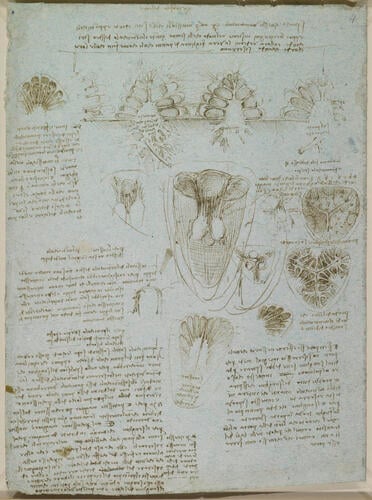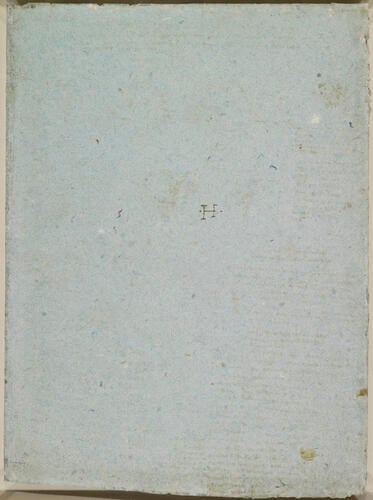-
1 of 253523 objects
The right ventricle and tricuspid valve c.1512-13
Pen and ink on blue paper | 28.4 x 20.9 cm (sheet of paper) | RCIN 919078
-
(The nominal recto of the sheet is blank, other than Melzi's inscribed .H.)
On the verso, a number of stylised drawings of the valves and ventricles of the heart, with many notes.
The largest drawing at the centre of the sheet shows the right ventricle sectioned longitudinally, thus revealing the papillary muscles (though their attachments are not apparent) and the chordae tendineae reaching up to the tricuspid valve. At centre right are two details of the valve when closed: the lower drawing shows it from the ventricular side, with the papillaries and chordae fanning out upwards; the upper drawing shows the valve from the atrial side, with letters purporting to indicate the points of attachment of the chordae on the other side of the cusps (Leonardo’s shading seems to suggest, wrongly, that the cusps are concave from this side). Leonardo has represented the chordae as regular and symmetrical, and he has placed the papillaries so that each muscle serves one cusp only, whereas in reality the papillaries are placed between the cusps.That layout is more correctly drawn in the diagram at the top of the page. Leonardo has envisaged cutting through the heart transversely both above and below the valve, thus giving a rough cylinder of the heart wall with the valve in the middle, and then cutting that cylinder longitudinally and opening out the tissue to a flat rectangle. The diagram therefore shows the three cusps of the valve lying flat against the heart wall, with the papillary muscles along the lower margin and their chordae fanning out to the cusps. The moderator band is seen, cut, attaching below the papillaries at left and right. Again the chordae are arranged too symmetrically (and at upper left is a diagram that shows the chordae in three distinct ranks), though Leonardo has also indicated, below the lower line of the diagram, a more irregular arrangement.
At lower centre is a longitudinal section through the left ventricle, with the two papillary muscles serving the two cusps of the mitral valve. Most of the notes discuss the physical arrangement of the cusps and chordae, except for one note in which Leonardo tries again to reconcile his understanding of the efficient functioning of the tricuspid valve, which prevents blood from pumping back from the right ventricle into the right atrium during systole, with the traditional physiology of the heart, which required the flux and reflux of the blood:
And if it should seem necessary to you that these gates should not be closed completely, because some blood ought to be breathed out and given to the lung, in this case blood is provided which is blown out of the ventricle before [the valve] is completely closed.
In other words, Leonardo accepted that the valves did attain perfect closure, but persuaded himself that some blood escaped back through the valve as it was closing. This can happen due to disease, but in a normally functioning valve such regurgitation is non-existent..
Text from M. Clayton and R. Philo, Leonardo da Vinci: Anatomist, London 2012Provenance
Bequeathed to Francesco Melzi; from whose heirs purchased by Pompeo Leoni, c.1582-90; Thomas Howard, 14th Earl of Arundel, by 1630; probably acquired by Charles II; Royal Collection by 1690
-
Creator(s)
Acquirer(s)
-
Medium and techniques
Pen and ink on blue paper
Measurements
28.4 x 20.9 cm (sheet of paper)
Other number(s)

